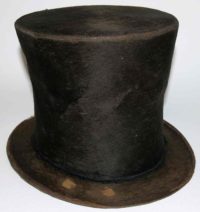 The most prized possession of many important artifacts in the Abraham Lincoln Presidential Library & Museum in Springfield, Illinois, is a stovepipe hat belonging to the president. The hat appears to have an impeccable provenance. Lincoln bought the beaver-fur stovepipe hat from a shop in Springfield in the mid-1850s, a period when he was active in state politics while aiming for national office, loudly voicing his opposition to the Kansas-Nebraska Act and transitioning from the dying Whig party to the Republican party. He paid $4.00 for it.
The most prized possession of many important artifacts in the Abraham Lincoln Presidential Library & Museum in Springfield, Illinois, is a stovepipe hat belonging to the president. The hat appears to have an impeccable provenance. Lincoln bought the beaver-fur stovepipe hat from a shop in Springfield in the mid-1850s, a period when he was active in state politics while aiming for national office, loudly voicing his opposition to the Kansas-Nebraska Act and transitioning from the dying Whig party to the Republican party. He paid $4.00 for it.
Lincoln’s tall stovepipe hat is so strongly associated with him that the outline alone is an iconic representation of the slain president. It was a deliberate choice of Abraham Lincoln’s to wear an extra tall chapeau to emphasize his atypical height. He was 6’4″ in an era when the average height for an adult male was 5’7″ and the hat is seven inches high. That made him just shy of seven feet tall when he wore it, a veritable giant even today.
Only three of Lincoln’s stovepipe hats are known to survive and the Springfield museum’s beaver hat is believed to be the oldest. The only problem is there is no hard evidence that the hat really did belong to Abraham Lincoln. The museum acquired it at auction in 2007. It was one of 1,600 Lincoln-related artifacts from collector Louise Taper that were bought for $25 million. The hat alone cost $6.5 million.
You’d think at those nosebleed prices the non-profit Abraham Lincoln Presidential Library Foundation (ALPLF) would investigate thoroughly before going deep into debt to buy the collection. Louise Taper was on the board of the foundation in 2007. That may or may not have played a part in the acquisition. She isn’t talking and neither is the foundation.
Since the hat entered the museum collection, the story told was that Lincoln had given the hat as a thank-you gift to an Illinois farmer in 1858. A descendant of the farmer signed an affidavit in 1958 confirming the gift, only she said Lincoln had given it to him during the farmer’s visit to Washington after 1861. The person who appraised the hat for millions of dollars did no personal research, relying solely on a report of research done by the foundation, a report that is nowhere to be found today.
In 2013, experts at the Smithsonian and Chicago History Museum reported that there was simply insufficient evidence to claim it as Lincoln’s hat. The affidavit is basically all they have to go on, and it contradicts the museum’s own statements. Without documentation of the hat having belonged to Lincoln, the museum should strongly qualify its claim that it was Lincoln’s stovepipe hat, the report concluded.
With $9.7 million still outstanding on the sale price and much fundraising needed to pay it off, in 2017 the ALPLF secretly asked the FBI to DNA-test residue on the hat in the hopes it might confirm conclusively that it once had topped Abraham Lincoln’s noggin. The conclusion was … inconclusive. No period DNA could be recovered, only contemporary DNA from someone who had handled it in comparatively recent years.
The hat may not have recoverable DNA, but it does bear some evidence of its wearer. It bears the mark of a hatmaker who was working in Springfield in the mid-1850s. It is Lincoln’s hat size. The band is stretched out from having had important papers stuffed inside of it, a practice Lincoln was known to indulge in. The are wear marks from two fingers on the brim, indicating that it was worn regularly by one individual for a very long time.
Museum chief Alan Lowe expressed frustration over the foundation’s secrecy, but downplayed the DNA test results, saying it would be hard to get a perfect match from an 180-year-old item handled by many people.
“It is important to understand that neither of these initiatives produced new evidence about the hat’s origins,” Lowe said in a statement.
Thanks to the publicity, the museum will begin a new search for evidence about the hat’s past, he added.
“What we learn, no matter what it says about the hat’s origins, will be shared with the public.”
Meanwhile, the pride and joy of the museum has been removed from public display. Once the research is done, the museum will decide whether the hat goes back on display at Lincoln’s lid or remains in the shadows as a $6.5 million pig in a poke.